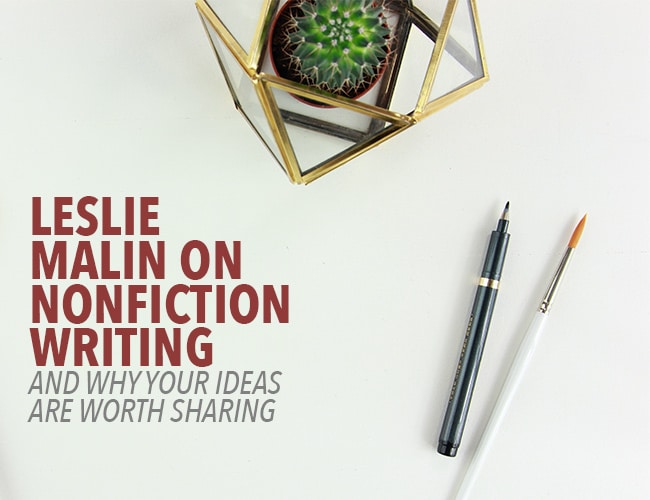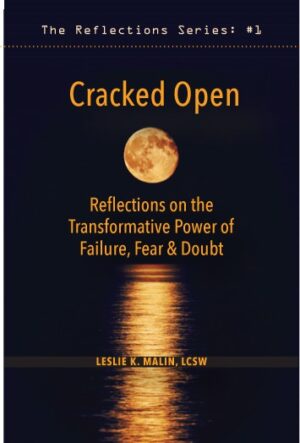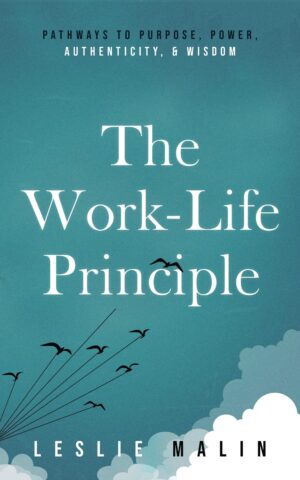Nonfiction writing seems like a completely different bear than writing fiction. How do you gather your ideas and present them in a coherent, interesting way? And if someone else has written on the same topic before, should you even bother?

Nonfiction, to me, seems way more intimidating to write and, quite frankly, seems like dry work. It reminds me of textbooks and yawning through late nights in college.
In today’s article, Leslie Malin gives us some great insight into how she came around to writing her first nonfiction book, her writing process, and the lessons she had to learn along the way. And she reminds us that writing nonfiction requires some of the same skills as writing fiction: storytelling.
Nonfiction writing isn’t that different
After talking with this month’s interviewee, I realized fiction and nonfiction writing have a lot in common. Neither are boring to write (or read!) if you are passionate about the subject matter. Both require knowledge of story arc and characterization. Both are born from a passion for the topic and an urge to let others see your words.
And, arguably most important, both are written to provide something to the reader, whether that be an escape or a solution to a problem.
Today we’re talking with Leslie K Malin, LCSW, author of Cracked Open and the forthcoming The Work-Life Principle, about writing nonfiction.
Leslie has a forty-year professional career as a psychotherapist, Career-Life Transition Coach, human resources training and development specialist, non-profit executive in mental health and social service agencies, public speaker, entrepreneur, author, and painter.
You can find Leslie online on on her Instagram and Facebook.
Here's how Leslie came about writing nonfiction:
Tell me a little about Cracked Open and what inspired you to write it.
This book emerged rather like a dream. I didn’t begin it with the intention of it becoming a book. I love quotations and found myself drawn to collecting quotations about failure, loss, doubt, hope, and overcoming challenges.
As my collection grew, it suddenly called to become a book. I don’t know how else to explain it. I reread each quotation and found myself writing a one-page “reflection” of each one, and kept adding. They became a meditation, a musing, a sharing of myself, a memoir of sorts.
This book became a calling for me to show-up authentically, honestly, and sometimes with a rawness that is not typical of me!
That sounds like an amazing experience with writing. Since this is so personal to you, how did you decide you wanted to publish it? What do you hope your readers will come away with after reading it?
This is an interesting question. Once it began to unfold more like a book, I began sending out new sections to five friends who would read them and respond to assess if they found the writing and way of presenting the material interesting. I also joined The Write Practice and began posting my writings weekly to see how they fared in an environment of mostly fiction writers.
While, in truth, I didn’t get lots of feedback, what I did receive from three or so writers so more than encouraging and supportive. Ruthanne Reid, whom I had really grown to respect, wrote to me, insisting that I finish this book. The feedback showed me that my experience, while personal, was also meaningful and motivating for others.
What did I want my readers to come away with after reading it? As a psychotherapist and life-career transition coach and other roles I’ve had, I knew firsthand how devastated people can feel post-failure, how self-doubt can be crippling, and how fear to move forward can envelop one’s soul.
Cracked Open is for everyone. Its message is that being human guarantees failure, fear, and doubt and, rather than shrinking us, they can become the portal to discover an expanded awareness, an opportunity for unanticipated growth, and a gift of immeasurable value.
We have a lot of advice for fiction writers on this blog, but a lot of writers don’t realize writing nonfiction can be very similar to writing fiction. For instance, you have to have a problem in both types of books, and that problem must ultimately be solved. Can you talk a bit about the similarities between writing nonfiction and fiction?
I’ve never written fiction — although I’d love to one day. However, I’ve read a ton of fiction from the masters to summer beach reading. Given my professional orientation as a psychotherapist and career-life coach, writing about life, work, the highs of success, and the depths of failure, writing nonfiction seemed like a natural genre for me.
Actually, I have become far more familiar with the similarities between fiction and nonfiction as I am writing my newest book, The Work-Life Principle: Pathways to Purpose, Passion, Authenticity and Wisdom. I workshopped the first draft by joining the 100 Day Challenge. This structure created the discipline to finally write the first draft which has been inhabiting my mind for years!
After the Challenge was over, I opted to work with a fabulous Story Grid coach (still in process). She is teaching me that nonfiction also has characters that play an enormously important role in “telling the story” of the mountain climb to purpose, passion, authenticity, and wisdom.
These characters are real people whom I have worked with individually and in groups as well as conducting a number of interviews to go deeper into people’s journey, challenges, struggles, and arriving at meaning. Then, in the writing I can share their experiences, thoughts, feelings, disappointments and successes.
They make the nonfiction come alive. They are the essence of nonfiction, aren’t they!
I am also learning that the structure of nonfiction shares another common ground with fiction. It has to have an arc which builds, crests, and then resolves. While the reader knows from the beginning where we are heading, they have no idea of how we will get there, what successes and allies we will find along the way nor where the shadows and cautions to proceeding will appear. And, finally, how the entire “story” will resolve.
This learning has been significant. I can look at my work in an entirely new way. I now see it as a Dorothy in OZ journey — a hero’s journey.
Even though you don’t write fiction, do you think there’s anything inherent to nonfiction that’s harder to write than fiction? Or vice versa?
I am actually a bit frightened of writing fiction! I am not sure that I have ever believed that I have the imaginative capacity to develop a compelling storyline with meaningful characters.
Yet, there is this longing to try my hand at it, just to see what it will call forth from me. What I might discover about myself, to push through the “FEAR” and practice what I preach! Stay tuned.
What do you think is the hardest thing about writing nonfiction?
To me, writing nonfiction has to have a specific issue or subject matter that matters to me and about which I have the experience, a point of view, and knowledge that can provide value to the reader.
Also, gaining clarity about who your audience is, forming an avatar of the perfect person who you are aiming your book towards can keep you on target and focused on the information that can most benefit as well as attract them. I have found that defining that avatar can be the most challenging piece of the process.
While I may believe that what I have to share could be valuable to many, it is definitely more compelling and relevant to some who may share an age or gender category, are at a particular stage in their lives and/or work, are in a similar socio-economic situation. It determines what kind of assumptions you may make, the kind of language you use, the stories you tell, etc. It doesn’t exclude others but it feels more of a fit for some.
You’ve mentioned before that you wrote your second book, The Work-Life Principle, in our 100 Day Book program. In that program, we focus on getting the first draft out on paper as fast as possible. Do you think that’s a beneficial process for writing nonfiction?
 As I mentioned briefly above, one of the best decisions I made was to join the 100 Day Book program. Without that challenge, I wonder if this book would still be looping around in my brain!
As I mentioned briefly above, one of the best decisions I made was to join the 100 Day Book program. Without that challenge, I wonder if this book would still be looping around in my brain!
The Challenge not only “forced” me to assign time to write, deadline and word counts to be accountable for, and helped me to just “put it down” on paper as rough and unstructured as it might be. The program taught me to let go of trying to be perfect and embrace what was to emerge.
It was a sort of brain-drain that would have time and space to be sorted out in the future. Once there is a first draft, there is a trajectory, a path, a distance and increased objectivity that I find to be invaluable.
You went into your second book with the full intention of it being a book, unlike the spontaneous emergence of your first. How was this different for you? Was the process more stressful?
The subject matter for The Work-Life Principle has been in my mind, some already written chapters, presented in an online seminar as well as in public speaking for many years. Its original title was “Finding Yourself on the Way to Work” as that is the essence of the book’s teaching.
When the 100 Day Challenge was announced, I was thinking of doing another book in the series of Reflections of Cracked Open. However, The Work-Life Principle wouldn’t let go of me and I felt that until I tackled that and finally put it down as a book that I couldn’t move onto something else. It was unfinished business and the fact that its substance has been a companion for so long meant that it demanded to be birthed.
The process has been more arduous — still is as I haven’t yet finished it, because it required more research, reading scholarly papers on the topics of work-life satisfaction, changes in needs as people reach mid-career and beyond, neuroscience and its discoveries about the brain and changes over time, and the like.
During the Challenge I only wrote down what I already knew and had thought through so that I could nail down a first draft. The research continues as does my evolving clarity about how to present the material to have impact and clarity, as well as a story-line.
I’ve conducted many interviews with people in different professions and stages in their lives to enrich the book with real-life stories and feedback from others about Purpose, Passion, Authenticity, and Wisdom in their work and careers. The interviews have been rich and rewarding but have thrown me off track from the writing.
I am on the return to writing phase now as well as working with my Story Grid editor which imposes an important but new demand.
What is the most difficult thing about writing for you? Have you overcome that obstacle and, if so, how?
Stay consistent in showing up to write.
I have a sizeable private psychotherapy and coaching practice that takes three full days of my time. Often, on my first day off I feel that I need to down-shift and do chores, etc. I also paint one day a week.
My challenge now is to take the deep dive and finish what I have begun. That means re-establishing disciple and scheduled times to write. I am returning to my editor with some set accountability dates to move forward and to perhaps take a week off from my practice and just write.
I am thinking about checking into a retreat house where there is enforced quiet and just settling in. I’m hoping that will recharge my batteries!
What advice would you give to other nonfiction writers just starting out?
Let yourself lay down that first rough, often messy, or gap filled draft. That can become the foundation of what follows. It’s a brain drain and allows you to get the material out of your head and looping thoughts and become a concrete, if unfinished, reality.
Maybe you’ll decide to publish it, perhaps you won’t — it doesn’t matter as much as working through it and building your author chops at the same time.
It’s all about the story
Whether you’re writing fiction, nonfiction, or memoir, remember that you’re telling a story. Your narrative arc must build, crest, and resolve, no matter the subject. This narrative arc is what people are used to and expect. Most importantly it’s what keeps your readers turning pages!
Thanks to Leslie for agreeing to talk with me!
You can find Leslie’s first book, Cracked Open, on Kindle or in paperback now! The Work-Life Principle will be available winter 2019. Be sure to sign up for Leslie’s newsletter or follow her on social media to stay in the loop with publication news!
If you were to write a nonfiction book, what would you write about? Let me know in the comments!
PRACTICE
Today I want you to choose a quote from this site. Don’t think too much about which one to choose. Then spend fifteen minutes freewriting on the quote. This doesn’t have to be structured in any way! You can use stream-of-consciousness writing if you choose.
Share your quote and your writing in the Pro Practice Workshop, and don’t forget to comment on your fellow writers’ work!
Not a member yet? Join us here.
Happy writing!
Sarah Gribble is the author of dozens of short stories that explore uncomfortable situations, basic fears, and the general awe and fascination of the unknown. She just released Surviving Death, her first novel, and is currently working on her next book.
Follow her on Instagram or join her email list for free scares.



0 Comments